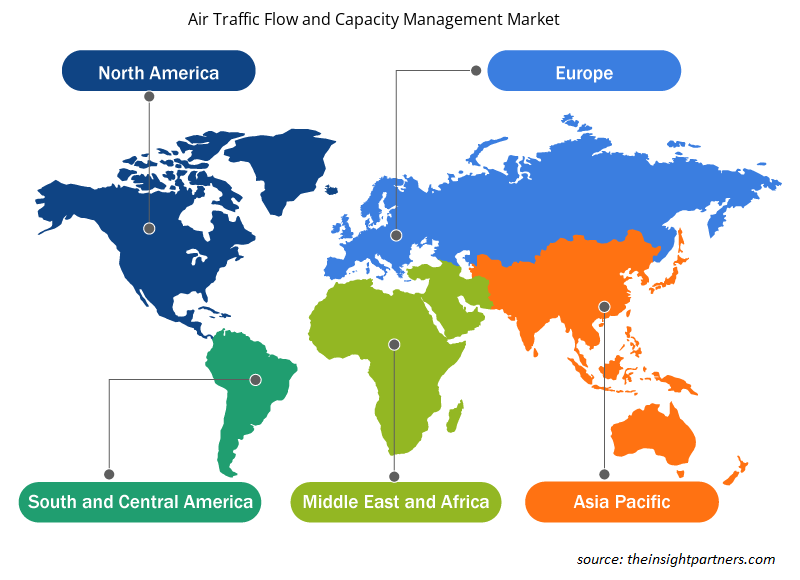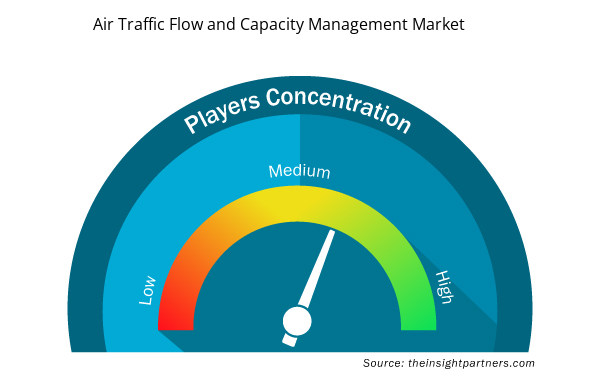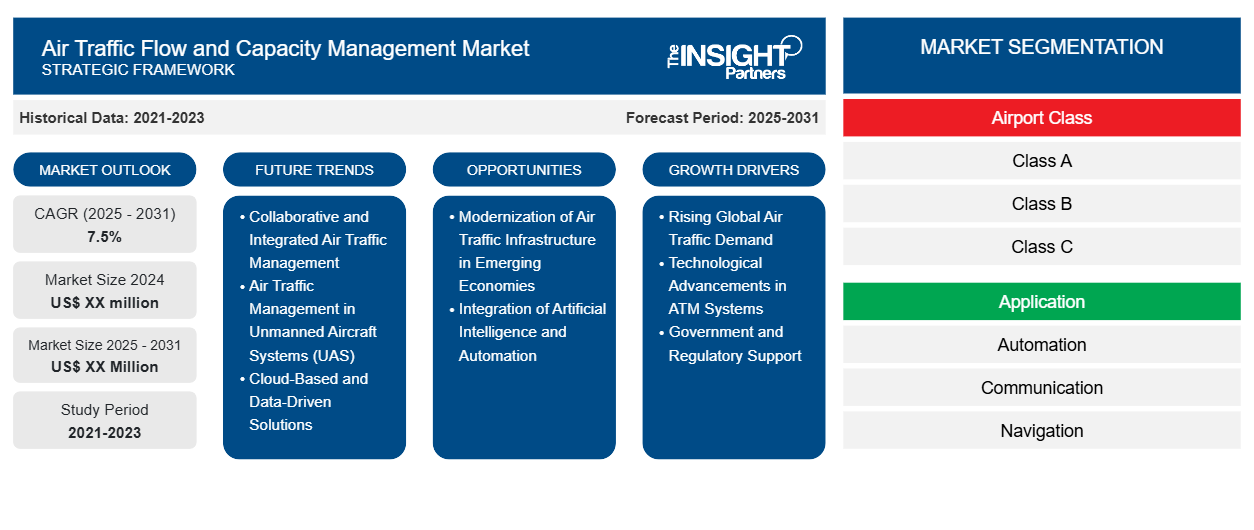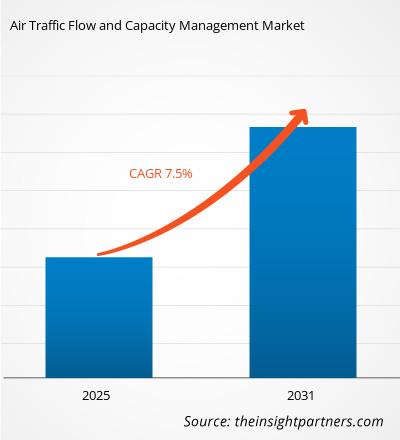Se espera que el mercado de gestión de capacidad y flujo de tráfico aéreo registre una CAGR del 7,5 % entre 2023 y 2031, con un tamaño de mercado que se expandirá de US$ XX millones en 2023 a US$ XX millones en 2031.
El informe está segmentado por clase de aeropuerto (clase A, clase B, clase C); aplicación (automatización, comunicación, navegación, simulación, vigilancia); usuario final (civil y comercial, militar y de defensa). El análisis global se desglosa aún más a nivel regional y por países principales. El informe ofrece el valor en USD para el análisis y los segmentos anteriores.
Propósito del Informe
El informe Air Traffic Flow and Capacity Management Market de The Insight Partners tiene como objetivo describir el panorama actual y el crecimiento futuro, los principales factores impulsores, los desafíos y las oportunidades. Esto proporcionará información a diversas partes interesadas del negocio, como:
- Proveedores/fabricantes de tecnología: Para comprender la dinámica cambiante del mercado y conocer las oportunidades potenciales de crecimiento, lo que les permitirá tomar decisiones estratégicas informadas.
- Inversionistas: Realizar un análisis exhaustivo de tendencias sobre la tasa de crecimiento del mercado, las proyecciones financieras del mercado y las oportunidades que existen en toda la cadena de valor.
- Órganos reguladores: Regular las políticas y vigilar las actividades del mercado con el objetivo de minimizar los abusos, preservar la confianza de los inversores y defender la integridad y la estabilidad del mercado.
Segmentación del mercado de gestión de capacidad y flujo de tráfico aéreo
Clase de aeropuerto
- Clase A
- Clase B
- Clase C
Solicitud
- Automatización
- Comunicación
- Navegación
- Simulación
- Vigilancia
Usuario final
- Civil y Comercial
- Militar y Defensa
Geografía
- América del norte
- Europa
- Asia-Pacífico
- América del Sur y Central
- Oriente Medio y África
Geografía
- América del norte
- Europa
- Asia-Pacífico
- América del Sur y Central
- Oriente Medio y África
Personalice este informe según sus necesidades
Obtendrá personalización en cualquier informe, sin cargo, incluidas partes de este informe o análisis a nivel de país, paquete de datos de Excel, así como también grandes ofertas y descuentos para empresas emergentes y universidades.
- Obtenga las principales tendencias clave del mercado de este informe.Esta muestra GRATUITA incluirá análisis de datos, desde tendencias del mercado hasta estimaciones y pronósticos.
Factores impulsores del crecimiento del mercado de gestión de capacidad y flujo de tráfico aéreo
- Aumento de la demanda mundial de tráfico aéreo: el continuo crecimiento del tráfico aéreo mundial, impulsado por el aumento del número de pasajeros y la demanda de carga, es un factor importante del mercado de gestión de la capacidad y el flujo del tráfico aéreo. A medida que los viajes aéreos se recuperan de la pandemia y se expanden, los aeropuertos y los proveedores de servicios de navegación aérea (ANSP) deben optimizar el espacio aéreo y la capacidad aeroportuaria para gestionar esta afluencia. Para dar cabida a este crecimiento manteniendo al mismo tiempo la seguridad y la eficiencia, se requieren sistemas avanzados de gestión del tráfico aéreo (ATM) para garantizar operaciones fluidas y eficaces. El aumento del tráfico aéreo ejerce presión sobre la infraestructura existente, lo que requiere mejoras en la gestión del flujo para evitar congestiones y retrasos.
- Avances tecnológicos en los sistemas ATM: Las innovaciones tecnológicas, incluida la adopción de inteligencia artificial (IA), aprendizaje automático (ML), automatización y análisis avanzado de datos, están transformando los sistemas de gestión del tráfico aéreo. Estos avances permiten optimizar en tiempo real el flujo de tráfico aéreo, predecir mejor los puntos de congestión y hacer un uso más eficiente de la capacidad disponible. La automatización en las torres de control del tráfico aéreo y los sistemas avanzados de gestión de vuelos reducen los errores humanos y aumentan la eficiencia operativa, lo que impulsa la necesidad de soluciones mejoradas en la gestión del flujo de tráfico aéreo y la capacidad.
- Apoyo gubernamental y regulatorio: Los gobiernos y los organismos regulatorios de todo el mundo están dando cada vez más prioridad a la modernización de los sistemas de gestión del tráfico aéreo para mejorar la seguridad, reducir los retrasos y mejorar la eficiencia ambiental. Las iniciativas regulatorias, como el Cielo Único Europeo (SES) en Europa, están impulsando una gestión colaborativa e integrada del espacio aéreo, lo que impulsa las inversiones en soluciones de gestión del flujo del tráfico aéreo. Además, los gobiernos están incentivando el desarrollo de sistemas ATM más eficientes para cumplir con los objetivos de sostenibilidad, reduciendo las emisiones de carbono mediante la optimización de las rutas de vuelo y el uso del espacio aéreo.
Tendencias futuras del mercado de gestión de capacidad y flujo de tráfico aéreo
- Gestión del tráfico aéreo integrada y colaborativa: una tendencia clave en el mercado de gestión de la capacidad y el flujo del tráfico aéreo es el cambio hacia sistemas de gestión del tráfico aéreo integrados y colaborativos. Iniciativas como SESAR (Investigación ATM del Cielo Único Europeo) en Europa y NextGen en los EE. UU. tienen como objetivo crear una infraestructura de control del tráfico aéreo unificada y sin fisuras en todas las regiones. Esta colaboración permite una mejor coordinación entre los controladores de tráfico aéreo, las aerolíneas y los aeropuertos, mejorando el flujo del tráfico aéreo a través de las fronteras nacionales. Los sistemas integrados facilitan el intercambio de datos en tiempo real y mejoran la toma de decisiones, lo que ayuda a gestionar las limitaciones de capacidad y reducir los retrasos.
- Gestión del tráfico aéreo en sistemas de aeronaves no tripuladas (UAS): el auge de los drones y los sistemas de aeronaves no tripuladas (UAS) es otra tendencia emergente que está reconfigurando la gestión del flujo de tráfico aéreo. La gestión del tráfico de UAS (UTM) se está convirtiendo en un aspecto esencial del mercado de gestión del tráfico aéreo, ya que estos sistemas requieren una infraestructura dedicada para una integración segura con los vuelos tripulados. Los gobiernos y los organismos reguladores están desarrollando marcos UTM para garantizar la operación segura y eficiente de los drones en el espacio aéreo congestionado. A medida que se expanda el uso comercial de los drones, la UTM se convertirá en una parte fundamental de la gestión de la capacidad general del tráfico aéreo, lo que creará una tendencia hacia la inclusión de la gestión de drones en los sistemas ATM tradicionales.
- Soluciones basadas en la nube y basadas en datos: Los sistemas de gestión de capacidad y flujo de tráfico aéreo están adoptando cada vez más tecnologías basadas en la nube y soluciones basadas en datos. Estos sistemas ofrecen ventajas significativas, como una mayor escalabilidad, acceso a datos en tiempo real y una implementación rentable. Los sistemas basados en la nube permiten la centralización de las operaciones de gestión del tráfico aéreo, lo que facilita la coordinación entre múltiples partes interesadas, incluidos aeropuertos, aerolíneas y proveedores de servicios de navegación aérea. El análisis de datos desempeña un papel fundamental en la optimización del tráfico aéreo, la predicción de puntos de congestión y la mejora de la toma de decisiones mediante el análisis de datos de vuelo históricos y en tiempo real. Estas tecnologías son cruciales para permitir soluciones de gestión del tráfico aéreo más flexibles y con mayor capacidad de respuesta.
Oportunidades de mercado en gestión de capacidad y flujo de tráfico aéreo
- Modernización de la infraestructura de tráfico aéreo en las economías emergentes: Las economías emergentes, en particular las de Asia-Pacífico, África y América Latina, están invirtiendo fuertemente en la modernización de su infraestructura de gestión del tráfico aéreo. A medida que aumenta el tráfico aéreo en estas regiones, existe una gran oportunidad de implementar nuevos y avanzados sistemas de gestión de la capacidad y del flujo de tráfico aéreo. Estas regiones buscan mejorar la capacidad aeroportuaria, mejorar la seguridad y optimizar el uso del espacio aéreo mediante tecnologías modernas de gestión del tráfico aéreo. Las empresas que ofrecen soluciones de vanguardia para la gestión del tráfico aéreo pueden sacar provecho de estos mercados en crecimiento proporcionando sistemas escalables y rentables que satisfagan las demandas de las industrias de la aviación en expansión.
- Integración de la inteligencia artificial y la automatización: la integración de la inteligencia artificial, el aprendizaje automático y la automatización en la gestión del flujo de tráfico aéreo ofrece importantes oportunidades para mejorar la eficiencia operativa. La inteligencia artificial puede analizar grandes cantidades de datos de vuelo para predecir patrones de tráfico, optimizar las rutas de vuelo y gestionar la congestión en tiempo real. La automatización en el control del tráfico aéreo puede reducir los errores humanos y aumentar el rendimiento, lo que permite operaciones más fluidas incluso en condiciones de mucho tráfico. Las empresas que invierten en el desarrollo de soluciones de gestión del tráfico aéreo basadas en inteligencia artificial pueden obtener una ventaja competitiva en un mercado cada vez más impulsado por la innovación tecnológica.
Perspectivas regionales del mercado de gestión de capacidad y flujo de tráfico aéreo
Los analistas de Insight Partners explicaron en detalle las tendencias y los factores regionales que influyen en el mercado de gestión de capacidad y flujo de tráfico aéreo durante el período de pronóstico. Esta sección también analiza los segmentos y la geografía del mercado de gestión de capacidad y flujo de tráfico aéreo en América del Norte, Europa, Asia Pacífico, Oriente Medio y África, y América del Sur y Central.

- Obtenga datos regionales específicos para el mercado de gestión de capacidad y flujo de tráfico aéreo
Alcance del informe de mercado sobre gestión de capacidad y flujo de tráfico aéreo
| Atributo del informe | Detalles |
|---|---|
| Tamaño del mercado en 2024 | XX millones de dólares estadounidenses |
| Tamaño del mercado en 2031 | US$ XX millones |
| CAGR global (2024 - 2031) | 7,5% |
| Datos históricos | 2021-2023 |
| Período de pronóstico | 2025-2031 |
| Segmentos cubiertos | Por clase de aeropuerto
|
| Regiones y países cubiertos | América del norte
|
| Líderes del mercado y perfiles de empresas clave |
|
Densidad de actores del mercado de gestión de capacidad y flujo de tráfico aéreo: comprensión de su impacto en la dinámica empresarial
El mercado de gestión de capacidad y flujo de tráfico aéreo está creciendo rápidamente, impulsado por la creciente demanda de los usuarios finales debido a factores como la evolución de las preferencias de los consumidores, los avances tecnológicos y una mayor conciencia de los beneficios del producto. A medida que aumenta la demanda, las empresas amplían sus ofertas, innovan para satisfacer las necesidades de los consumidores y aprovechan las tendencias emergentes, lo que impulsa aún más el crecimiento del mercado.
La densidad de actores del mercado se refiere a la distribución de las empresas o firmas que operan dentro de un mercado o industria en particular. Indica cuántos competidores (actores del mercado) están presentes en un espacio de mercado determinado en relación con su tamaño o valor total de mercado.
Las principales empresas que operan en el mercado de gestión de capacidad y flujo de tráfico aéreo son:
- Tecnologías ALTYS
- Sistemas BAE
- frecuencia
- ENAIRE
- Tecnologías L3Harris, Inc.
Descargo de responsabilidad : Las empresas enumeradas anteriormente no están clasificadas en ningún orden particular.

- Obtenga una descripción general de los principales actores clave del mercado de gestión de capacidad y flujo de tráfico aéreo
Puntos de venta clave
- Cobertura integral: el informe cubre de manera integral el análisis de productos, servicios, tipos y usuarios finales del mercado de gestión de capacidad y flujo de tráfico aéreo, proporcionando un panorama holístico.
- Análisis de expertos: el informe se compila sobre la base de un profundo conocimiento de expertos y analistas de la industria.
- Información actualizada: El informe asegura relevancia comercial debido a su cobertura de información reciente y tendencias de datos.
- Opciones de personalización: este informe se puede personalizar para satisfacer los requisitos específicos del cliente y adaptarse adecuadamente a las estrategias comerciales.
Por lo tanto, el informe de investigación sobre el mercado de gestión de capacidad y flujo de tráfico aéreo puede ayudar a abrir camino para descifrar y comprender el escenario de la industria y las perspectivas de crecimiento. Si bien puede haber algunas preocupaciones válidas, los beneficios generales de este informe tienden a superar las desventajas.
- Análisis histórico (2 años), año base, pronóstico (7 años) con CAGR
- Análisis PEST y FODA
- Tamaño del mercado Valor/volumen: global, regional, nacional
- Industria y panorama competitivo
- Conjunto de datos de Excel


- Energy Recovery Ventilator Market
- Real-Time Location Systems Market
- Adaptive Traffic Control System Market
- Flexible Garden Hoses Market
- Pharmacovigilance and Drug Safety Software Market
- Playout Solutions Market
- Fertilizer Additives Market
- Identity Verification Market
- Sports Technology Market
- Procedure Trays Market

Report Coverage
Revenue forecast, Company Analysis, Industry landscape, Growth factors, and Trends

Segment Covered
This text is related
to segments covered.

Regional Scope
North America, Europe, Asia Pacific, Middle East & Africa, South & Central America

Country Scope
This text is related
to country scope.
Preguntas frecuentes
Some of the customization options available based on the request are an additional 3-5 company profiles and country-specific analysis of 3-5 countries of your choice. Customizations are to be requested/discussed before making final order confirmation, as our team would review the same and check the feasibility.
The report can be delivered in PDF/PPT format; we can also share excel dataset based on the request.
The leading players operating in the Air Traffic Flow and Capacity Management Market include ALTYS Technologies, BAE Systems, Frequentis, ENAIRE, L3Harris Technologies, Inc., Honeywell International Inc., Intelcan Technosystems Inc., Leonardo S.p.A., Metron Aviation, Inc.
The Air Traffic Flow and Capacity Management Market is estimated to witness a CAGR of 7.5% from 2023 to 2031
Focus on Automation and Emphasis on Sustainability is the key future trend of the Air Traffic Flow and Capacity Management Market
The major factors driving the Air Traffic Flow and Capacity Management Market are: Increasing Air Travel and Advancements in Technology
Trends and growth analysis reports related to Aerospace and Defense : READ MORE..
1. ALTYS Technologies
2. BAE Systems
3. Frequentis
4. ENAIRE
5. L3Harris Technologies, Inc.
6. Honeywell International Inc.
7. Indra
8. Intelcan Technosystems Inc.
9. Leonardo S.p.A.
10. Metron Aviation, Inc.
The Insight Partners performs research in 4 major stages: Data Collection & Secondary Research, Primary Research, Data Analysis and Data Triangulation & Final Review.
- Data Collection and Secondary Research:
As a market research and consulting firm operating from a decade, we have published and advised several client across the globe. First step for any study will start with an assessment of currently available data and insights from existing reports. Further, historical and current market information is collected from Investor Presentations, Annual Reports, SEC Filings, etc., and other information related to company’s performance and market positioning are gathered from Paid Databases (Factiva, Hoovers, and Reuters) and various other publications available in public domain.
Several associations trade associates, technical forums, institutes, societies and organization are accessed to gain technical as well as market related insights through their publications such as research papers, blogs and press releases related to the studies are referred to get cues about the market. Further, white papers, journals, magazines, and other news articles published in last 3 years are scrutinized and analyzed to understand the current market trends.
- Primary Research:
The primarily interview analysis comprise of data obtained from industry participants interview and answers to survey questions gathered by in-house primary team.
For primary research, interviews are conducted with industry experts/CEOs/Marketing Managers/VPs/Subject Matter Experts from both demand and supply side to get a 360-degree view of the market. The primary team conducts several interviews based on the complexity of the markets to understand the various market trends and dynamics which makes research more credible and precise.
A typical research interview fulfils the following functions:
- Provides first-hand information on the market size, market trends, growth trends, competitive landscape, and outlook
- Validates and strengthens in-house secondary research findings
- Develops the analysis team’s expertise and market understanding
Primary research involves email interactions and telephone interviews for each market, category, segment, and sub-segment across geographies. The participants who typically take part in such a process include, but are not limited to:
- Industry participants: VPs, business development managers, market intelligence managers and national sales managers
- Outside experts: Valuation experts, research analysts and key opinion leaders specializing in the electronics and semiconductor industry.
Below is the breakup of our primary respondents by company, designation, and region:

Once we receive the confirmation from primary research sources or primary respondents, we finalize the base year market estimation and forecast the data as per the macroeconomic and microeconomic factors assessed during data collection.
- Data Analysis:
Once data is validated through both secondary as well as primary respondents, we finalize the market estimations by hypothesis formulation and factor analysis at regional and country level.
- Macro-Economic Factor Analysis:
We analyse macroeconomic indicators such the gross domestic product (GDP), increase in the demand for goods and services across industries, technological advancement, regional economic growth, governmental policies, the influence of COVID-19, PEST analysis, and other aspects. This analysis aids in setting benchmarks for various nations/regions and approximating market splits. Additionally, the general trend of the aforementioned components aid in determining the market's development possibilities.
- Country Level Data:
Various factors that are especially aligned to the country are taken into account to determine the market size for a certain area and country, including the presence of vendors, such as headquarters and offices, the country's GDP, demand patterns, and industry growth. To comprehend the market dynamics for the nation, a number of growth variables, inhibitors, application areas, and current market trends are researched. The aforementioned elements aid in determining the country's overall market's growth potential.
- Company Profile:
The “Table of Contents” is formulated by listing and analyzing more than 25 - 30 companies operating in the market ecosystem across geographies. However, we profile only 10 companies as a standard practice in our syndicate reports. These 10 companies comprise leading, emerging, and regional players. Nonetheless, our analysis is not restricted to the 10 listed companies, we also analyze other companies present in the market to develop a holistic view and understand the prevailing trends. The “Company Profiles” section in the report covers key facts, business description, products & services, financial information, SWOT analysis, and key developments. The financial information presented is extracted from the annual reports and official documents of the publicly listed companies. Upon collecting the information for the sections of respective companies, we verify them via various primary sources and then compile the data in respective company profiles. The company level information helps us in deriving the base number as well as in forecasting the market size.
- Developing Base Number:
Aggregation of sales statistics (2020-2022) and macro-economic factor, and other secondary and primary research insights are utilized to arrive at base number and related market shares for 2022. The data gaps are identified in this step and relevant market data is analyzed, collected from paid primary interviews or databases. On finalizing the base year market size, forecasts are developed on the basis of macro-economic, industry and market growth factors and company level analysis.
- Data Triangulation and Final Review:
The market findings and base year market size calculations are validated from supply as well as demand side. Demand side validations are based on macro-economic factor analysis and benchmarks for respective regions and countries. In case of supply side validations, revenues of major companies are estimated (in case not available) based on industry benchmark, approximate number of employees, product portfolio, and primary interviews revenues are gathered. Further revenue from target product/service segment is assessed to avoid overshooting of market statistics. In case of heavy deviations between supply and demand side values, all thes steps are repeated to achieve synchronization.
We follow an iterative model, wherein we share our research findings with Subject Matter Experts (SME’s) and Key Opinion Leaders (KOLs) until consensus view of the market is not formulated – this model negates any drastic deviation in the opinions of experts. Only validated and universally acceptable research findings are quoted in our reports.
We have important check points that we use to validate our research findings – which we call – data triangulation, where we validate the information, we generate from secondary sources with primary interviews and then we re-validate with our internal data bases and Subject matter experts. This comprehensive model enables us to deliver high quality, reliable data in shortest possible time.


 Obtenga una muestra gratuita de este informe
Obtenga una muestra gratuita de este informe